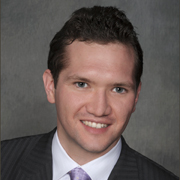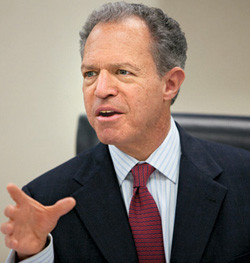New venues launch as order flow remains less than plentiful; are there enough trades to go around?
Competition among options exchanges has ratcheted up from fierce to fiercer.
Top-dog exchange operators including Chicago Board Options Exchange, NYSE Euronext, International Securities Exchange and Nasdaq OMX are rolling out new bells and whistles to wrest a percentage point or two of market share from the next guy. Smaller players such as Bats Global Markets and Box Options Exchange are pushing to move up to the next level. Miax Options Exchange joined the fray just last year, and ISE is planning to launch a new venue in the second quarter.
As the options-exchange field (supply) expands, order flow (demand) remains off levels from a couple years ago, so there’s less business to go around.
“There is increased competitive pressure, whether from pricing or new products and services,” said Steve Crutchfield, chief executive of NYSE Euronext’s Amex and Arca options exchanges. “There is ongoing pressure to differentiate yourself and win and maintain business, and certainly that pressure has increased over the past couple years.”

Steven Crutchfield, CEO, NYSE Amex Options
“There is ongoing pres- sure to differentiate yourself and win and maintain business, and certainly that pressure has increased over the past couple years.
Of about 312 million options contracts traded in March, CBOE led exchange operators with about 27.8% market share, which included 25.9% for its main exchange and 1.86% for its C2 venue, according to Options Clearing Corp. Nasdaq was close behind with 26.9%, comprising 17.9% for its PHLX exchange, 8.13% for its Nasdaq exchange, and 0.86% for its BX exchange.
NYSE Euronext was third among exchange operators with a market share of 24.2%, spanning 13.4% for Amex and 10.8% for Arca; ISE weighed in at 15.2% for its one exchange. After that it’s a big dropoff to Bats at 3.76%, Box at 2.06%, and Miax at 0.18%.
“All the exchange entities out there, except for the newest ones where it’s too early to say, have viable businesses,” Crutchfield told Markets Media. “Some competitors have been in the business for years but they’ve have never had much more than a handful of percentage points in market share.”
Finding Niches
With the burgeoning field of exchanges — 11, heading to 12 — one concurrent trend has been for individual exchanges to try to differentiate themselves by going after targeted areas within the options market. This is in sharp contrast to the landscape back in the 1990s, when four big exchanges (CBOE, Amex, Arca nee Pacific Stock Exchange, and PHLX) each offered a broad, all-things-to-all-people model.
“Now you see exchanges focusing more on their respective niches,” Crutchfield said. “We see more differentiation and exchanges trying to carve out their own niche for order flow.”

Boris Ilyevsky, Managing Director at ISE
There is some difference of opinion as to how meaningful that niche-carving-out process is. Some options order routers and trade handlers say options exchanges’ battle to differentiate themselves manifests itself mostly in minor, superficial tweaks such as fee-structure changes. For their part, exchanges maintain they have been rolling out true innovation. Ultimately, innovation is in the eye of the beholder.
“We’re trying to push ourselves by offering functional enhancements that are unique offerings and differentiate us competitively apart from the fee structure,” said Boris Ilyevsky, managing director at ISE.
Prices can be matched, so true innovation lies in functionality, which works out best for the innovating exchange itself as well as the marketplace. “Functionalities are more difficult to copy,” Ilyevsky told Markets Media, citing implied orders for the complex order book as an example.
“Ultimately it is the market participants, the market makers and order-flow providers, who decide whether a new exchange makes it.”
Last August, ISE completed the roll-out of implied-order functionality for all products in its complex order book. Implied orders can improve prices on component legs of complex-order options trades and enables more interaction of multi-legged and regular orders. ISE said the functionality tightened spreads on its regular order book, resulting in better trade executions for both complex and non-complex options trades.
“We’ve been alone for almost a year with implied-order functionality which enhances the fill rates of multi-legged strategy orders, basically spreads,” Ilyevsky said. “This has really enhanced the way people trade spreads and brought a lot of spread business to the ISE.”
ISE has also added stock-execution venues for types of stock orders like buy-writes and delta-neutral orders, and the exchange is developing functionality to support trade-through protection for complex orders.
“We’re trying very hard to offer new functionalities and new capabilities,” Ilyevsky said. “We want to compete on more than just whose rebate fees are higher or whose taker fees are lower.”
Chicago-based CBOE, whose CBOE exchange matches the most trades among the 11 U.S. options bourses, had a dominant 95% market share in index options in March. The company is best-known for its Volatility Index (VIX), and by extension has a strong reputation for new-product development.

Bill Brodsky, chief executive of Chicago Board Options exchange
As might be expected for a leading exchange, CBOE’s bread and butter is the high end of the market. In a February statement, CBOE Chief Executive Bill Brodsky cited the “ability to leverage our higher-margin, proprietary products” as a primary driver behind CBOE Holdings’ strong financial results in 2012.
“One of the beauties of the options market is that not only has it encouraged people to buy and own stocks, but also it’s a way of protecting gains.”
Nasdaq’s PHLX exchange reported market share of almost 18% in March, down about three percentage points from the year-earlier period, when there were two fewer options exchanges. PHLX recently launched exchange-traded options on U.S. Treasuries, overlaying the most recently issued “on-the-run” 10-year notes and 30-year bonds which allow investors to hedge interest rate risk with more precision.
Nasdaq’s launched BX Options, its third exchange, in June 2012. BX Options had a market share of less than 1% in March, suggesting that it’s not yet on the radar screens of most options order handlers.
Next Up
The project name for ISE’s second exchange is Topaz, but Ilyevsky said the venue will have a different name, to be revealed closer to launch.
“We recognize that fragmentation is an issue,” Ilyevsky said. “It has been an issue for quite some time on the cash side, where they have more many exchanges and also several dozen or so dark pools that many firms have to connect to at a cost…Ultimately it is the market participants, the market makers and order-flow providers, who decide whether a new exchange makes it and reaches any kind of critical mass.”
Ilyevsky noted it costs less to connect to a new exchange of an existing-exchange operator, compared with a new exchange owned by a new-face exchange operator.
“Anyone connected to us right now doesn’t need any new connectivity, and the testing will be very minimal — they’re already connected to our data centers and have developed whatever functionality is needed for our technology platform,” Ilyevsky explained. “It is our plan to make it as painless and effortless as possible to participate in the second exchange. That doesn’t mean there aren’t costs and fees, but it’s our job to make the exchange an attractive destination.”
Ilyevsky said ISE’s new exchange will ultimately offer meaningful differentiation on functionality, but for now the exchange isn’t saying exactly how. “There are new ideas” that ISE is holding close to the vest for competitive reasons, he said.
“The most important part for us in this very long process is to get to the starting line, to get people connected and started up with something they’re very familiar with, and initially look at offering an alternative fee structure,” Ilyevsky said. “Whatever fee structure we decide to use for the second exchange, just by the fact that we have pro rata and customer priority, it may be the only one of its kind.”
The new venue should cannibalize the existing ISE exchange only minimally if it is positioned and priced appropriately. “We’re very hopeful that we’ll compete and offer a good alternative to the other exchanges and pricing and market structures out there,” Ilyevsky said.
To be sure, it’s one thing for a start-up exchange to avoid cannibalizing its own sister exchange and grab market share from competitors. It’s another thing entirely for a new exchange to grow the proverbial pie, that is to have an offering so compelling that it brings in new order flow from traders and investors who hadn’t been trading options. This is the ‘holy grail’ for a new exchange, which if achieved would have all market participants in favor of expanding the exchange field.
“When we initially launched in 2000 we did exactly that, and that also might be something you could say about some of the exchanges that launched a while ago,” Ilyevsky said. “But I couldn’t tell you that any of the recently launched exchanges, just by virtue of coming to market, have expanded the pie. Growing the overall pie is certainly part of our long-term goal.”
By way of describing the NYSE Euronext options exchanges, Crutchfield said Amex is a more retail-friendly model that offers free trade execution, while Arca is driven toward trying to be at the top of the market via attractive liquidity-provider rebates.
“In our Arca market we have moved to a make/take pricing structure and eliminated payment for order flow,” Crutchfield said. “Since then Arca’s market share in the non-penny names on electronic trading increased, from 4.7% in October to 7.9% in January. By instituting a program where market makers are incentivized to provide liquidity, it has really helped us grow that part of our business.
“At Amex we’ve approached it a bit differently,” Crutchfield said. “We’ve continued to strive to make Amex the top destination for retail investors, with real, genuine investor order flow. There are a lot of types of customers, and on the Amex all of our customer executions are executed at no cost irrespective of the size of the order. We’re the only exchange with that model, and the market has really recognized that.”
Crutchfield said NYSE Euronext has been busy adding and upgrading offerings to customers. Most recently, the exchange operator introduced mini options, which launched with “significant” activity that is expected to ramp higher. “Bringing in order flow from investors at the retail level is good for the industry as a whole,” Crutchfield said.
Also, “we eliminated position limits in (SPDR S&P 500 options) at the end of last summer and since then several other exchanges did the same, and we’re waiting for Finra to do the same,” Crutchfield said. “We think that will help grow the business more from the institutional community by making the SPY product a more attractive destination for customers who might have preferred to trade proprietary index products, like SPX on the CBOE.”
NYSE Amex expanded the short-term options program on multiple-listed single stocks and ETFs in 2010. Since then, the weekly options have expanded to as much as 16% of total options volume, Crutchfield said.
“Amex was the first exchange to file and be approved to expand the weekly options program, from one week to five weeks,” Crutchfield said. “It’s hard to tell whether this added volume or shifted volume around, but we’re very comfortable with the growth we’ve seen. It gives investors a finer level of granularity — if Apple has earnings in three weeks, maybe you don’t want to trade one week or one month, you want three weeks.”
NYSE Euronext plans to launch an electronic-auction mechanism in the second quarter, to better compete with the auction products of competing options exchanges.
Adding Value
Regarding any new exchange, Crutchfield said there should be true differentiation for it to be worthwhile. “I don’t see value to the market from someone starting another options exchange just to be another Amex or NYSE Arca, basically copy their market structure and try to win business that way,” he said. “To the extent that we have new entrants coming into the space, my hope would be that they would diversify the industry in some way that would help grow the pie for all of us.”
For their part, the newer and smaller players say they do bring something to the table.
According to the Miax Options Exchange, the five-month-old trading venue offers competitive pricing based on a low-cost operating structure, superior customer service, and outstanding technology. The initial focus is to “leverage management’s expertise and relationships in the equity options space.”
Still, those are fairly broad characterizations that arguably are the same bailiwick as other exchanges. As is the case for ISE’s planned new options exchange, Miax’s true differentiation is planned for
later.
“Miax also intends to launch the Miax Equities Exchange and plans to pursue Latin American equity listings,” the company says on its web site. “The vision for the Miax Equities Exchange is to become a marketplace that enables access to the Latin American markets, a place where global Hispanic entrepreneurs can seek capital and growth opportunities, and an exchange where Latin American companies will want to be listed. MIAX believes…Latin American companies will be interested in listing on both the MIAX Options and Equities Exchanges because of its presence in Miami.”
CBOE’s C2 exchange reported market share of 1.86% in March, up from 1.31% in the year-earlier period. Launched in October 2010, all-electronic C2 offers a maker-taker fee schedule and a modified price-time matching algorithm for multiple listed classes.
Despite being just two and a half years old, C2 is essentially C2 2.0 after CBOE overhauled its pricing structure last year. “We elected to retool C2 entirely, not merely just as another payment for order flow model, but as an innovative alternative that provides a pricing plan unlike anything else in the options industry,” Brodsky said. “Fees and rebates are based primarily on C2’s market width at the time of the trade. Tighter spreads are rewarded with lower fees and rebates are also based on the width of the spread.”
“Although feedback from C2 participants is very positive, we are not expecting to see immediate results,” Brodsky said. “Unlike a simple fee change, C2 offers an entirely new approach to pricing, consequently it takes a bit more time on the front end for firms to fully acclimate to the new C2. Ultimately, we believe spread pricing in combination with C2’s new DPM model will provide the maximum incentive for order-flow providers to route orders to C2.”
Options exchanges face competitive risk from each other, and also regulatory risk. Among the multitude of new, developing, or proposed financial rules, one recent initiative coming out of Washington has especially caught the eye of options exchanges.
Regulatory Threat
Dave Camp, chairman of the U.S. House Ways and Means Committee, has proposed new rules aimed at making the tax code simpler and fairer. One of the specific thrusts of the proposal would implement uniform tax treatment for financial derivatives, including options.
According to a release issued by the Camp, a Republican Congressman from Michigan, “the proposal seeks to modernize tax rules to minimize Wall Street’s ability to hide and disguise potentially significant risks through the abuse of derivatives and other novel financial products – an activity that was a contributing factor to the 2008 financial crisis.”
Options market participants say the proposed rules are misguided and would unfairly penalize retail investors and by extension crimp order flow. If the rules are implemented as drafted, an investor who seeks to hedge an equity position via options could find himself or herself owing taxes for gains underlying stock position even without selling the stock.
“One of the beauties of the options market is that not only has it encouraged people to buy and own stocks, but also it’s a way of protecting gains by buying puts or selling calls,” CBOE’s Brodsky told Markets Media. “Retail customers are huge participants in the options market — these are taxable investors who should be encouraged to buy and hold stocks and use options in a way that is constructive for the investor and for the market.”
“I look at this as a big challenge,” Brodsky said. The proposed legislation “collides with what I think are well-established and well-functioning policies and procedures as it relates to the options market, which causes us great concern specifically as it relates to qualified covered calls and protective puts.”
Brodsky, a 30-year exchange veteran with strong history of advocating for the financial sector, said he and others are on the case. “We are working very hard in Washington to try to have people understand and not try to fix something that’s not broken,” he said. “The options industry is highly mobilized, all the exchanges are working together…People are frightened with the potential negative consequences.”

